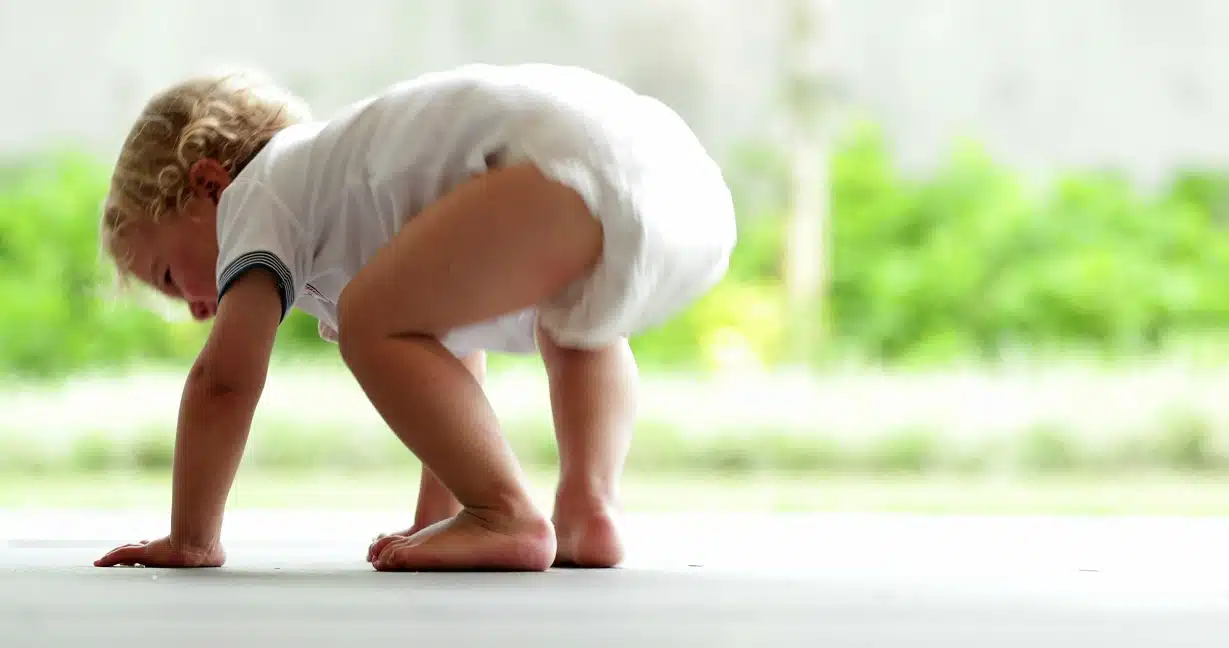By: Nicole Crisan, PT, DPT
Independent mobility allows children to explore and interact with their environment. One way that a child gains this independence is by walking. Independent steps emerge between the ages of 10-15 months, but before those first steps comes a series of developmental milestones that prepare a child for independent walking. These pre-walking skills, which include coordination, control, balance, and strength, are crucial steps in their physical and cognitive development, setting the stage for their journey towards mobility and exploration. Here are some activities that can help them work towards taking their first steps:
- Pulling-to-stand: A child places both hands on a surface, places one foot in front of them, and then pulls themselves into a standing position. This helps them work on strengthening, balance, and coordination. Here are some activities to promote this skill:
- Place toys/preferred objects on top of a surface to motivate your child to transition into a standing position
- First use a surface that is slightly below chest level to make it easier for your child to place their hands on the surface
- Play in a tall-kneeling position with hands on a vertical surface (wall), stacked pillows, or a low surface where they can rest their forearms on to work on their hip and core strength
- Perform sit-to-stand transitions: child is seated on your lap or small step. A toy/preferred object is placed on a surface a few inches away from the child. Assist in placing their hands onto the surface and shifting their weight forward onto their feet as they start to transition into a standing position.
- Cruising: A child walks sideways as they hold onto surfaces/furniture. This helps to work on balance and weight shifting. Here are some activities to promote this skill:
- When a child is standing on a flat surface, place a toy/preferred object away from them either to their right or left as motivation to take steps sideways. You can assist them to take steps by placing your hands on their hips and shifting their weight onto their right and left leg which will then allow them to lift their non-weight bearing leg and take a step. For example: shifting their weight onto their right leg allows the child to take a sidestep with their left leg.
- Encourage your child to take steps towards both the right and left directions
- As your child starts to take sidesteps with greater fluidity, you can start having them cruise between two surfaces that are placed right next to each other or behind each other.
- While playing at a glass door or wall, can encourage cruising along a vertical surface
- Standing: Standing independently is a precursor to taking independent steps as your child learns to improve their balance, strength, and control. Here are some activities to promote this skill:
- Standing with the child’s back against the wall/sofa. Stand in front of your child and encourage them to reach forward
- Elevating one of your child’s legs by placing a pillow or a book under one foot while they are playing at a stable surface to work on lateral weight shifts and balance
- When your child is standing by a stable surface, place toys/preferred objects on the floor next to their feet to encourage them to squat down to pick it up while they hold onto the surface. You can also place toys/objects on a slightly elevated surface to make this activity easier
- When your child is standing at a stable surface, place toys on another surface that is behind them or to the sides of them to encourage them to reach and rotate their body to work on balance and ankle stability and strength.
- Pushing a surface: As your child learns to take reciprocal steps, you can help your child push a diaper box, push toy, or laundry basket. Can provide support by helping your child lift their feet and take steps.
- Taking steps with handheld assistance: Provide your child with one or two handheld assistance as they start to take reciprocal steps. Keep your child’s arms at or slight below chest level as if they fall, you do NOT want to keep their arms up above their chest due to risk of Nursemaid’s Elbow/Pulled Elbow.
Conclusion
The journey to taking independent steps is a significant milestone in every child’s early development. By providing a nurturing environment, engaging in play-based activities, and offering support as needed, you can help your child build the necessary skills and confidence to take their first independent steps. Celebrate each small achievement along the way, knowing that each step helps grow your child’s independence and abilities!
Note: Every child develops at their own pace, and it’s essential to monitor their progress and consult with healthcare professionals if you notice delays or have concerns regarding your child’s motor skills development. Early intervention can often address any issues and support your child’s continued growth and development.




